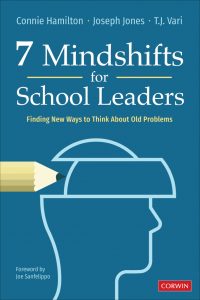
Frederick White: The Labyrinth of Leadership #OneThingSeries
Success is not established by winning all the time. ~ Frederick White
About Frederick White
Dr. Frederick White is the COO of Digital PD 4 You, LLC and the author of
the book, The Skin You Are In: Colorism in the Black Community, the First (2020) and Second (2021) Edition. Frederick has served as a leader in the educational field for twenty-four years.
Dr. White has also spent the past fourteen years serving as an AVID staff development instructor. Dr. White obtained a Doctorate in Educational Leadership from Trevecca University and currently serves as a principal of a middle school in Memphis-Shelby County Schools in Tennessee.
His newest book is The Labyrinth of Leadership: Navigating Your Way Through the Maze, which we talk about on the show along with so much more leadership insight for school leaders who are looking to lead better and grow faster.
Follow Frederick on Twitter @fdwhite02 to get his bi-weekly Labyrinth of Leadership tips for school leaders.
What You’ll Find in this Podcast Episode with Frederick White
The Labyrinth of Leadership, as Fredrick explains it, is a solicitation of ideas from leaders around the country–folks with “skin in the game.”
Don’t miss what Dr. White says about his personal take-away from the Labyrinth project.
Listen to the language he uses, so important and grossly undervalued.
Frederick talks about self-reflection as a universal need for leaders. It’s all about finding the time.
Dr. White tells us about the importance of defining the “end product.” This part is profound.
He says that the greatest leaders are the ones who are willing to continue to grow, regardless of how much they have achieved.
Joe asks Frederick to explain one of his recent tweets about celebrating small wins. Every school leader needs to hear this.
Dr. White talks about the difference between goal setting and dream chasing. This alone is worth the listen. Be a dream chaser!
You want to hear the part about failure being the struggle that we often need to grow. Frederick’s butterfly story is awesome.
Frederick mentions both Principal Kafele and Todd Whitaker as inspiration.
Check out The Principal Project.
Advice from Dr. White: pause and go for a walk. Just taking the time to walk and observe is powerful for peace, self-reflection, and a solid reminder of what we want and need.
Frederick is striving for the most perfect environment he can provide. His reflection about this is great.
To continue to grow, Frederick starts by never settling. He looks to be present with his teachers to learn from them. He mentions writing and researching as things that force him to continue to grow.
Books We Recommend Based on this Podcast with Frederick White
What Great Principals Do Differently by Todd Whitaker
Is My School Better Because oI Lead It by Baruti Kafele
Let us know if there’s a guest who you want us to have on the show by leaving a comment below or by contacting us at [email protected]. And don’t miss our leadership content updates every week by subscribing on the site.
We can’t wait to hear from you.









 7 Mindshifts for School Leaders: Finding New Ways to Think About Old Problems.
7 Mindshifts for School Leaders: Finding New Ways to Think About Old Problems. 


